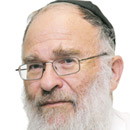Pondering the implications of time
 YOSSI ARON
YOSSI ARON
AS a general rule, the festival of Succot draws our attention to the fragility of the spaces in which we live.
As we move from our houses to sit in the succah, we become directly exposed to the vagaries of nature from which we are otherwise shielded; the focus after Yom Kippur is once again, albeit in a different manner, on the frailty of the frameworks that determine human lives.
However, as we celebrate Succot this year, it is the artificiality of another dimension of our lives that comes to the fore. And that is the dimension of time.
For well over three decades, most Australians have changed clocks twice a year. Each spring we put our clocks forward one hour to maximise the number of daylight hours during which we are awake and active. Each autumn this process is reversed, as we return to “standard time”. And each year we do this without question, without really pondering its implications.
This year, however, is the first instance when the time change in Australia will take place in a manner that creates a halachic issue for observant Jews. The clocks will change at 2am on the morning of Sunday, October 4, the second day of Succot -— in the midst of yom tov.
The laws of yom tov do not allow adjustment of clocks -— meaning that unless it is done prior to Shabbat (in which case clocks in the house on Shabbat will differ from those elsewhere), the necessary adjustment will have to wait until after yom tov ends.
Accordingly, in an Orthodox household, the time shown on clocks throughout that Sunday will remain as standard time, while the world around us will see a time one hour ahead. At least as far as shul services are concerned, each congregation will have to clarify to its members exactly when services on that Sunday are to commence.
But given that the issue is now raised, perhaps we should take the opportunity to consider a few pertinent points. The impact of the halachic ban on adjusting clocks reinforces to us that, in reality, time as we know it is nothing but an artificial construct.
Measurement of time as we know it worldwide today is a comparatively modern phenomenon. While even mechanical clocks have existed for many centuries, only the 19th-century advent of the railway, with the timetables essential to its operation, made a uniform time system necessary in Europe and then the rest of the world. Prior to that, each town or village had its own local time based around midday as fixed by observation.
That is in fact the origin of the adornment of town halls or major post offices with clock towers that set the time for the inhabitants of the town or village to follow.
And in eastern countries the determinant of time took another form. Here too the ancient concept of a 12-hour day was in force, but here it was the cry of the muezzin at sunset that marked 12.00. No matter that this happened at a different moment each day, varying with the weeks let alone the seasons of the year. Jews too took note of this mode of determining time.
In his halachic writings, the Sephardi sage Ben Ish Chai specifically defines the beginning of the day as the time of the muezzin’s call to prayer — sunset. There are still remains of that time system in the standard luach (Hebrew calendar) designed by Rabbi Yechiel Michoel Tukyszinsky, used by traditional Ashkenazi Jews in Jerusalem, whereby sunset is designated as 12.00 and other times designated for ritual purposes follow accordingly.
Halachic time is determined not by the clock but by natural phenomena — light and dark, night and day — as they impact on halachic observance past and present. It is that same interplay that underpins the very first mishnah of the Talmud (Berachot 1:1). From when do we read Shema in the evening?
From the time that the priests may eat terumah. We are told thereby that the basic law of reading Shema each evening has its time defined as the same moment that defined Temple-related purification laws allowing a priest to eat sanctified food.
As emphasised by Rabbi Joseph B Soloveitchik in his magnum opus Halachic Man, from a Torah perspective, natural phenomena have cosmic significance that extends to spiritual realms. In that light, an artificial clock created by humans has no relevance to religious practice predicated on the natural order created by God.
Indeed, as we become closer to nature leaving our houses this Succot, this lesson is doubly reinforced.
Yossi Aron is The AJN’s religious affairs editor.

comments